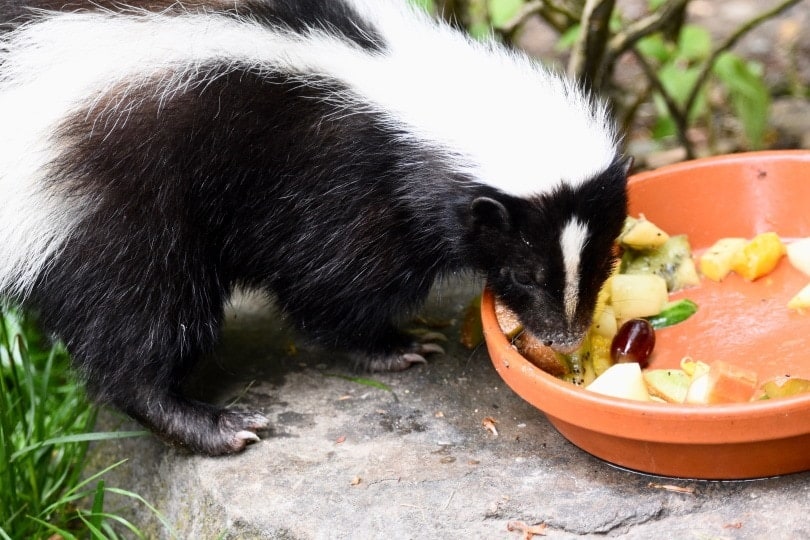Skunks are mammals identifiable by their characteristic black-and-white striping. They’re also well-known for their unpleasant “skunk spray,” as they produce a foul odor as a means of self-defense. These wild creatures have a reputation for scavenging food in human neighborhoods and are often treated as pests. However, some people keep them as domesticated pets in their homes.
If you are having trouble with skunks invading your trash can every night, you might be wondering what foods these creatures naturally eat. In the wild, skunks mostly feed on insects and small animals.
You should know that feeding wild skunks will just encourage them to keep coming back. These animals are omnivores and not overly picky when it comes to food. So, let’s take a closer look at their background and what constitutes their main diet.

What Do Skunks Eat?

Skunks are omnivorous creatures; therefore, they can adapt to any diet. During summer and spring, most of their food consists of insects and small prey.
When the food is scarce, they turn to eating plants. However, during winter, skunks can have problems accessing food, and this is when they invade trash cans for food. They tend to eat more during summer when there’s a lot of food, which helps sustain them and their young ones during the cold months.
Since they have scavenger tendencies, their diet is adaptable depending on seasons and availability. Due to their size, they can only attack animals that are smaller than them. When they can’t find prey to kill, they have to survive on plants and in worse-case scenarios, edible foods from your garbage can.
Let’s look at the main foods that skunks eat.
Insects and Small Animals
Despite their unpleasant odor, skunks are beneficial to humans in several ways. On average, 70% of the skunk’s diet is made up of harmful insects. They prey on creatures that affect a human’s typical lifestyle. Therefore, as much as they are a nuisance to humans, they help get rid of destructive insects in the house and yard.
Skunks feed on cockroaches, grasshoppers, snakes, crickets, beetles, scorpions, spiders, mice, moles, tiny frogs, bees, and worms. They will also target ground-nesting birds, fish, and some small reptiles.
Skunks prey on some animals as a means to teach the young ones self-defense. For this, they chose to target dangerous animals, such as snakes and the black widow spider. Their immunity to snake venom helps them eat poisonous ones, such as rattlesnakes. These creatures are also the primary predators of the honeybee. Their thick coat of fur protects them from getting bee stings.
Therefore, apart from getting a nutritious diet, they use this to teach their young ones how to attack prey and defend themselves.
See also: What Killed My Chicken? How to Determine the Killer

Plants
Skunks prefer eating animals over plants. However, depending on the time of the year, plant material may be the most available food.
During the colder months, especially winter and fall, there are fewer food sources for the skunks. Therefore, they have no option but to eat fruits and crops that are rotting on the ground. They forage for food at night and are notorious for their digging habits.
The plant materials that skunks feed on include edible leaves, nutritious grasses, berries, mushrooms, corn, grapes, and chilies. In addition, skunks can eat nuts, seeds, plant roots, and dead plant matter.
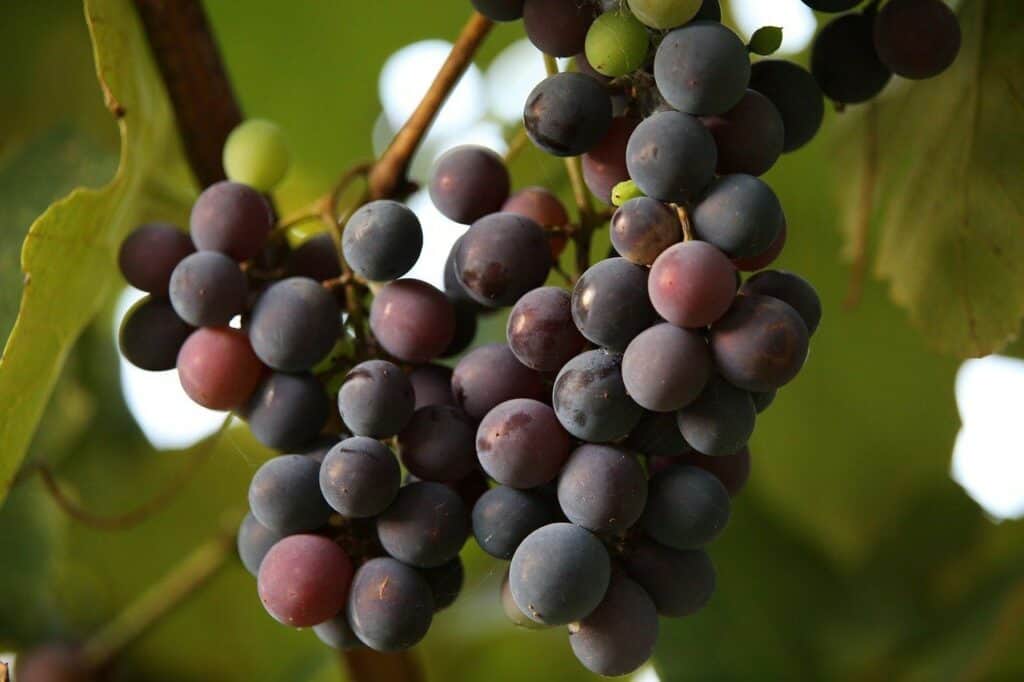
What Do Skunks in Urban Areas Eat?
In extreme cases, when skunks can’t access food at all, they will choose to invade homes and eat any foods that they can get around your property. These can be decaying plants or garbage. These invasions are an annoyance to most humans, as these animals leave visible damage on the yard.
Skunks will raid garbage and trash, looking for their favorite food, which can be messy. Therefore, most people have devised methods to keep them away from their properties or trap them.
Skunks get attracted to unattended garbage, which will often contain their favorite foods, such as insects and rodents. In addition, when foraging, they will feed on leftovers and rotting food because they are very adaptable.
However, skunks become more threatening to humans when they can’t get food in the garbage. They can go a step further and target BBQ grills and compost piles. If skunks constantly visit your home to look for food, they’ll probably come back several times.
As animals of routine, once they locate a steady food source in your property, they’ll visit more often, especially during winter when there’s less food and prey around. Their destructive habits and intolerable odors have made them one of the most disliked animals by humans.
You’ll easily know when skunks visit your yard. They leave behind a foul odor and holes about 3–4 inches wide in your lawn. These creatures have extreme digging habits that they use when looking for insects. They can damage your house’s foundation if they decide to construct a burrow underneath the house.
The other signs to look out for include damaged corn on your farm, raided poultry houses with missing eggs or chickens, and skunk tracks, with five toes on each foot. However, the odor will be the most prominent because the spray has a range of up to 10 feet, and the odor travels about 1.5 miles.
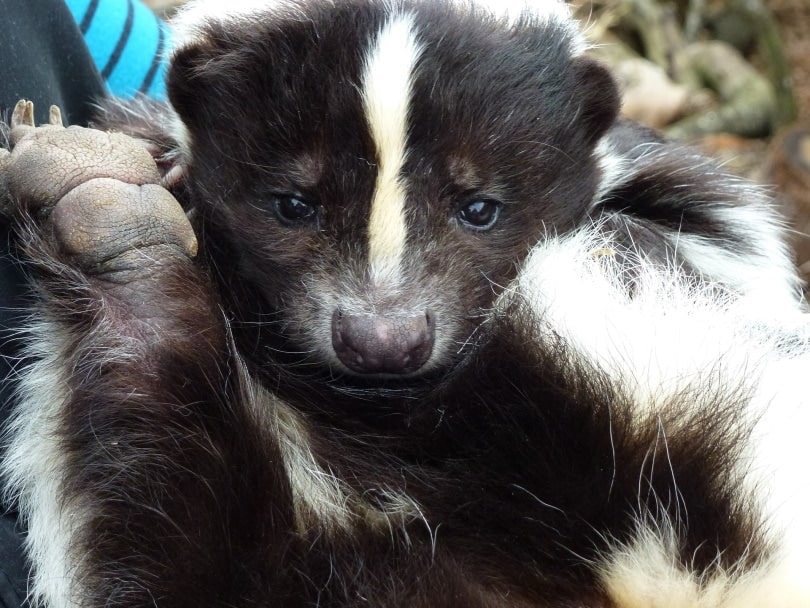
Domestication of Skunks
Skunks are typically wild animals. However, you can domesticate one if the law in your location allows. Domesticated skunks are allowed in most states in the United States, the U.K., Germany, Canada, the Netherlands, and Italy.
Apart from the legality issues, taking a skunk out of the wild to keep as a pet puts you and your family at risk of contracting harmful parasites and rabies. If you are considering keeping one as a pet, contact a reputable breeder or rescue center instead. Also, have them neutered or spayed.

Feeding Pet Skunks
Before bringing a skunk to your home, research the diet recommendations, vaccines required, and other care items that this animal will need. It might be challenging to get a vet specializing in these exotic animals; therefore, you’ll need to be thorough in your research.
In the wild, skunks feed on pretty much everything. Therefore, their food demand is primarily a high-caloric diet. However, since they are prone to obesity, you should feed your pet skunk a low-fat diet. In addition, this diet is suitable because they have low energy requirements.
Skunks require a mix of fruits, vegetables, carbohydrates, and protein. In a day, you can feed them twice and include all the nutrients in one meal. Baby skunks that are less than 4 months old need to eat more and be fed four times a day, like puppies. They also need a balance of all the necessary nutrients to help with growth.
A varied healthy diet for a skunk should include the following.
Proteins
Proteins should make up about 60–70% of your skunk’s diet. Foods that can be a source of protein include meat, dairy products, raw chicken, marrow bone, canned salmons, sardines, and cheese. You can also include raw or cooked eggs.
Skunks love insects, so if you can get crickets, worms, mice, or cockroaches, these can supplement their diet. Seeds like almonds, pumpkin, and sunflower are also high in proteins and fats.
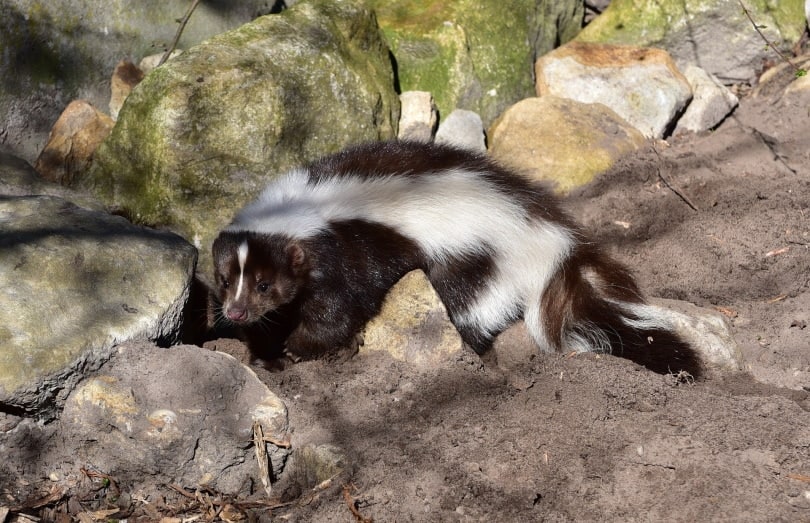
Vegetables
Of your pet’s daily diet, vegetables should make up 30–40%. You can choose from a wide variety of vegetables, including broccoli, bell peppers, cauliflower, red cabbage, spinach, kale, lettuce, zucchini, carrots, eggplants, cucumbers, and tomatoes. These can be served either raw or frozen.
Your skunk will also happily eat cooked foods, such as sweet potatoes, potatoes, yams, and butternut squash. These should be well-cooked and only served a few times a month.
Despite these being healthy, don’t feed your pet skunk vegetable-heavy diets; otherwise, they’ll lose bone mass. Complement these foods with lots of proteins and vitamins.
Fruits
Skunks love berries; therefore, it’s safe to offer your pet blueberries, raspberries, blackberries, and strawberries. You may also include bananas, melons, apples, and pears for a balance.
Minerals
A good diet for your pet also includes a mix of vitamins and minerals. Your vet can recommend the supplements to include in the diet. The essential nutrients that your pet needs include calcium for bone growth and vitamin D.
Skunks are highly susceptible to bone issues and arthritis; therefore, you can add calcium supplements on top of the chicken and cheese. If they have a low-protein diet, you can add a taurine supplement to aid in muscle formation.

What Not to Feed Them
Once you get a pet skunk, there are a few foods that you should avoid feeding them to keep them healthy and within the right weight.
Cat and Dog Food
Commercial cat and dog food have too much fat and protein content that can be too high for your pet skunk. These foods should be used as a last option when your skunk won’t eat any other food.
Processed Foods
Avoid feeding your skunk fried foods, potato chips, chocolates, sweets, and other processed foods that are high in sugar and fat content. Your pet skunk will gain weight within a short time due to the poor diet and lack of exercise.

Are There Any Commercial Skunk Foods?
Yes, there are plenty of commercial foods for skunks. However, these have to be ordered online directly from the manufacturer.
You can also get nutritional supplements and canned insects to provide protein for your skunk. That said, if you can make the meals by yourself, it’s much more manageable.
What Are the Nutrition-Related Health Issues?
A healthy skunk has an average lifespan of about 5 years as a pet and approximately 5–10 years while living in the wild. If the skunk is not getting the proper nutrients, they are prone to health conditions, such as obesity. This mostly affects pet skunks that have little physical activity.
With weight issues, they could also get diabetes, kidney disease, and cancer, which affects their quality of life and shortens their life cycle.
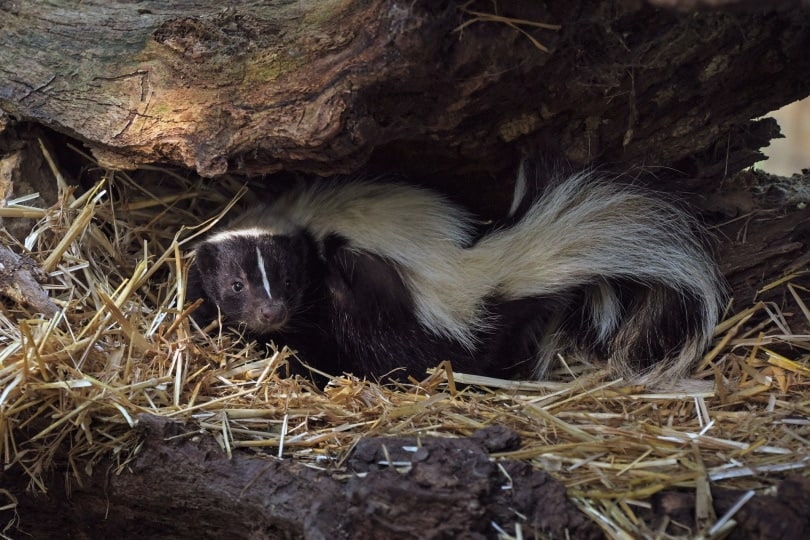

More About Skunks
Origin
Skunks were first identified in the 1630s. The striped skunk is the most recognizable species in North America.
The spotted skunk is also present in most parts of the U.S. and Mexico; however, the population is lower. In the Midwest, Southwest, and Mexico, you can see the hooded and hog-nosed species.
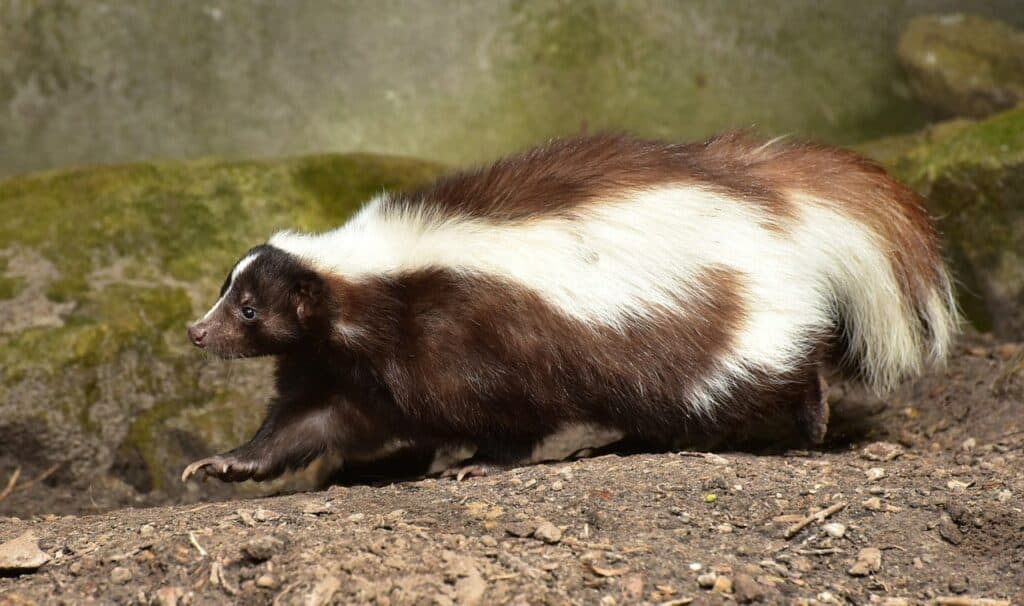
Physical Attributes
Skunk species vary in size. Spotted skunks are lighter and weigh about 1–3 pounds, whereas striped ones can weigh more than 15 pounds. Their bodies are relatively short, with well-muscled legs and long claws used for digging. Each foot has five toes.
Due to cross-breeding, these animals come in different colors and patterns. However, the most prominent pattern is the classic black and white. Other skunk patterns range from brown, grey, spotted lavender, and white and cream.
From birth, all skunks are striped, but some might have some white spots and broken stripes, which are characteristic of the spotted skunk.
Habitat
Skunks are adaptable creatures and can easily thrive in different habitats provided that there’s shelter and food. These animals prefer to live within 2 miles of a water source, so they will rarely travel far from their established homes.
If you are looking for their habitat, you are likely to find them in hollowed-out logs, animal burrows, and tree hollows and underneath porches. When they can’t access shelter options, they dig their own burrows.
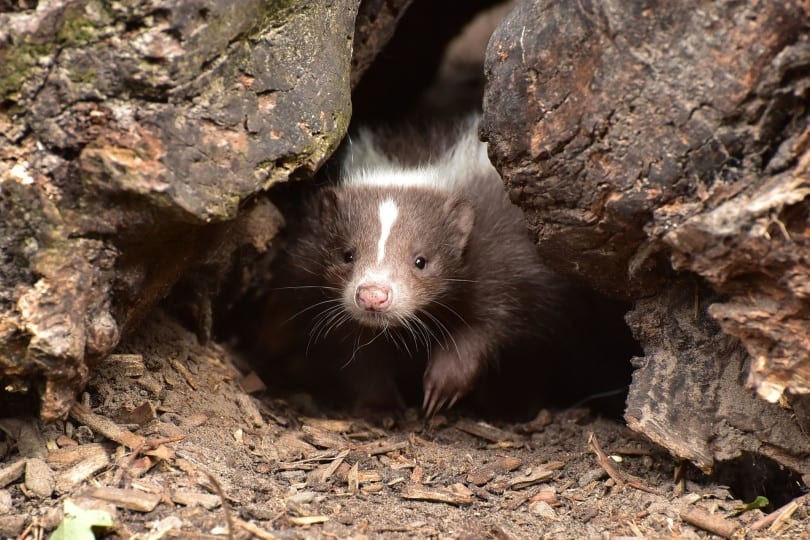

Final Thoughts
Skunks are easy feeders. As omnivores, they can eat both plant and animal materials. The wild ones have a negative relationship with humans. They are known to scavenge through trash cans looking for food, leaving a mess and an unpleasant odor in the yard.
That said, some skunks have been domesticated and are kept as pets. Their feeding regimen needs to include a well-balanced diet to keep them healthy. However, there’s still a lot of information to be researched on how you can take care of a skunk in your home.
Featured Image Credit: Delovely Pics, Shutterstock
